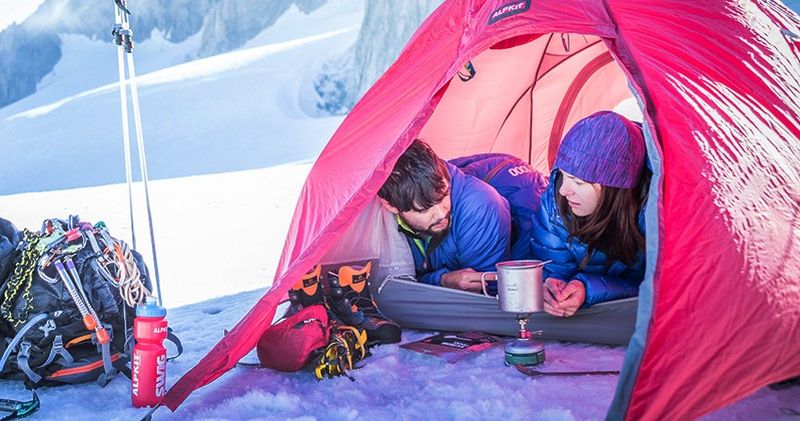Sleeping bags are a thing of beauty. The feeling you have when you slide into one after a long day’s walking, escaping the cold and entering a realm of comfort and warmth cannot be underestimated. And, generally speaking, down sleeping bags are often just that bit warmer and more comfy than synethetic bags. So much so that sometimes it can feel as though you are wrapped up in the clouds.
We’ve already revealed the best synthetic sleeping bags. Now it’s time to bring you our verdict on six of the best down sleeping bags. The bags have been rated on weight, pack size, warmth, level of features and value. Read on to find out our thoughts, and let us know if you think we’ve missed off an absolute corker.
Alpkit Pipedream 400 Hydrophobic review
www.alpkit.com | £219.99
I’m a big fan of Alpkit gear and the firm’s Hunka bivy has served me well throughout the years. So I was keen to test out the PipeDream 400 Hydrophobic sleeping bag. It’s up there with the best looking down sleeping bags on test and it feels incredibly comfortable against the skin too.
The bag uses Nikwax Hyrophobic down, which is said to stay dry and retain loft up to 60 times longer than untreated down. A DWR coating also helps tackle any moisture issues. With a fill power of 750, the PipeDream offers a great deal of loft and we love how toasty it feels inside. We’d expect this bag to handle much of what Britain has to offer in terms of temperatures.
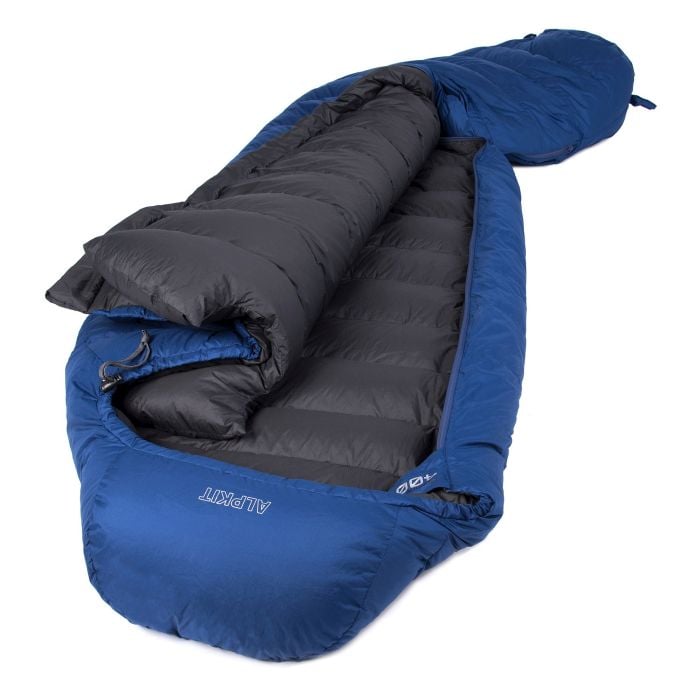
Unfortunately, we were slightly disappointed with the neck and zip baffle. It’s not very big and seemed like it was brushed aside fairly easily, affecting its ability to eliminate cold spots.
Although the neck baffle was well insulated, we would have preferred if it ran all the way around the bag rather than just in the chest area as there were gaps allowing cold air to flow into the bag.
The hood offered a great deal of insulation, but it was also slightly roomier than other down sleeping bags on test, and it needed much more adjustment to cinch in.
At 876g, we’d have no complaints carrying the PipeDream 400 around in our rucksack, especially considering its compact pack size. There was no zip pocket but drying loops are attached to the bottom of the bag.
In a line: The Alpkit Pipedream 400 is a warm and comfortable sleeping bag that would benefit from a few more features.
Weight: 8/10
Pack size: 8/10
Warmth: 8/10
Features: 7/10
Value: 8/10
Overall: 7.8/10
Vaude Marwees 500 Down review
www.vaude.com | £215
If you’re an environmentally-friendly traveller, you’ll no doubt be aware of the good work that Vaude’s doing with its products. Using sustainable materials and striving to improve the working conditions of its production facilities, the brand’s doing its bit to minimise its effect on the environment and the countries it manufactures in.
This ethos carries over to the Marwees 500 down sleeping bag which we tested in the Jan/Feb 2020 edition of Adventure Travel magazine.
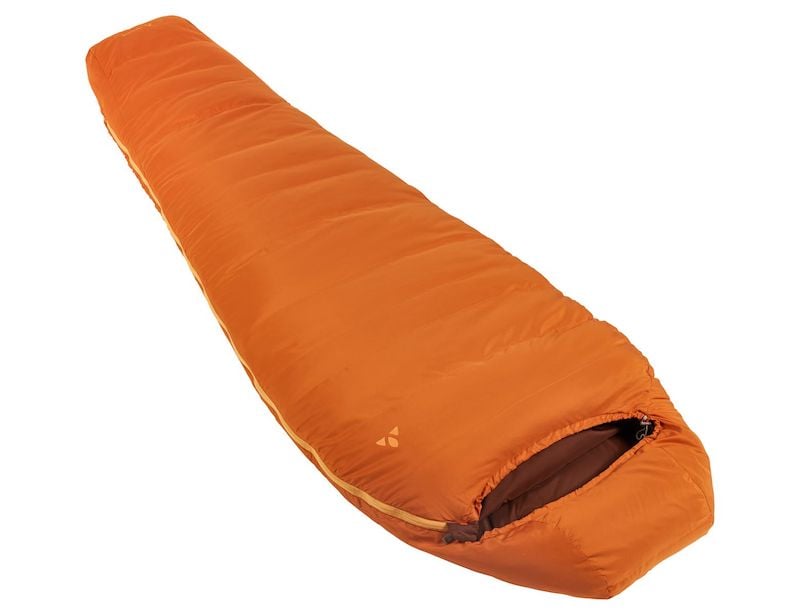
With a comfort rating of 2C, this is by no means the warmest sleeping bag around. In fact, I would rule this out for most winter adventures, but for three-season use it’s adequate (there is also a Marwees 700 available, which has a comfort rating down to -1C).
In keeping with Vaude’s commitment to sustainability, insulation in the Marwees 500 is provided by 500-fill power 100% recycled duck and goose down. This is contained in a series of effective horizontal baffles that do a great job of preventing down migration around the bag.
The two-way zip runs the length of the bag, and the baffle that back it is very well placed and effective. The zip also operates smoothly and it rarely snags. Once done up, the shoulder baffel can be tightened for a snug fit, while the hood is well designed and adjustable via a pull cord that’s useable with one hand.
The internal pocket is more of a gesture than a useable feature, being only about the size of a pack of playing cards.
The bag weighs in at 1,200g, which makes it pretty bulk and heavy for a down sleeping bag, but the compression sack that comes with it helps it pack down to about the size of a football. On the subject of the compression sack, I found it to be needlessly fiddly, thanks to its roll bag nature and clips.
The Marwees 500 is a decent bag from Vaude, lending itself more to spring and autumn use. If you like the look of it but want something that can handle colder weather, it’s well worth checking out its bigger brother, the Marwees 700.
In a line: A great option for eco-conscious travellers.
Weight: 6/10
Pack size: 7/10
Warmth: 7/10
Features: 8/10
Value: 8/10
Overall: 8/10
Mountain Equipment Helium 600 review
www.mountain-equipment.co.uk | £280
We loved Mountain Equipment’s entry into the synthetic sleeping bag test and we have to say, we’re just as enamoured with the brand’s entry into the down review too. Essentially, you literally feel like you are crawling into a cloud when you get into it. The comfort level is off the scale and this is matched by the bag’s performance.
With a lower limit of -8C you’d expect the Helium 600 to pack a punch, and it certainly does. The 700 fill power offers exceptional levels of loft and warmth, and once again Mountain Equipment offers a good night’s sleep guarantee, this time down to -10C. This means that if you don’t feel the bag is as warm as you expected, they will replace it with a warmer one.
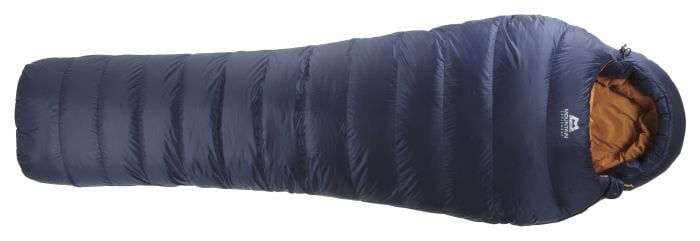
The Helium 600 performs in terms of features too, with a very good anti-snag zip and a comprehensive neck baffle and hood that we couldn’t fault at all. It pulls in very well around the neck and head, eliminating the risk of cold drafts creeping in.
The drawstring toggles are placed well out of the way and once you’ve crawled into the bag you’ll never want to leave. The zip baffle offers a good level of insulation too, though we’d prefer it to be a bit larger to reduce the danger of it being moved out of place when you fidget in the night.
We were also fans of the stuff sack which came in the form of a waterproof dry bag – great for protecting the bag when you’re on the move.
We also found the ergonomics of the bag to be pretty spot on. The foot box offered a great compromise between not too wide and not overly restrictive, while the upper body area had the optimum amount of space, though if you are tall you’ll want to opt for the longer version.
As good as the Helium 600 is, there are one or two things counting against it. While a lack of interior pocket is something that can be forgiven, we were a little disappointed that the pack size was one of the largest out of all down sleeping bags we tried in this group test. While this isn’t a deal breaker, there is some stiff competition in this review and others pack down smaller.
The same can be said for weight which, at 1,174g, is certainly nothing to be sniffed at, but this is the up there with the heaviest down sleeping bags we’ve tested. Get past that, though, and you’ve got a very, very good sleeping bag on your hands that is hard to beat.
In a line: The Mountain Equipment Helium 600 is an extremely warm, high-quality bag that will not disappoint. One of the best down sleeping bags on the market.
Weight: 8/10
Pack size: 7/10
Warmth: 10/10
Features: 9 /10
Value: 10/10
Overall: 8/10
Robens Couloir 350 review – £284.99
www.robens.co.uk | £284.99
The Robens Couloir range comes highly recommended by Adventure Travel magazine through our previous experiences with the bags, specifically the Couloir 500, which won Best in Test in a previous Adventure Travel down sleeping bag group review.
Like that bag, the Couloir 350 is different to most of the other sleeping bags in this test in that the zip runs down the middle of front of the bag (rather than down the side). The reason for this is to allow easier access in use and to allow the user to comfortably sit up with the bag partially open. Like a lot of things, a central zip on a sleeping bag is something I didn’t know I needed until I tried it – I like this method a lot!
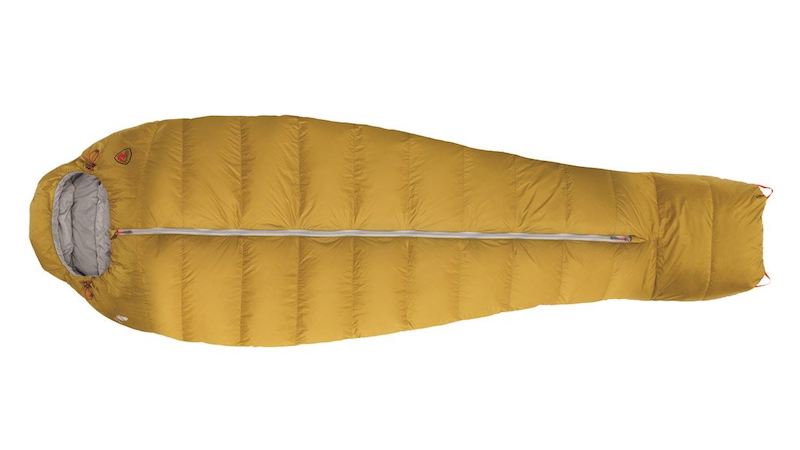
Straight out of the stuff sack, the first thing I noticed about the Couloir 350 was how decadently soft it was. Sleeping in this thing is a delightful experience, especially if you’re on the larger side as there’s plenty of room to wriggle about inside.
Insulation is provided by 350g of RDS certified duck down with a 700 fill power that’s contained in box-wall baffles to minimise cold spots. Warmth is almost immediate and the comfort rating of -4C is about spot on.
Despite the bag’s roomy sizing and levels of warmth, the packsize is an impressive 24x16cm (helped by the well-designed compression sack), and the weight is a pack-friendly 795g.
Warmth, comfort, and packsize aside, the bag features a two-way zip and it’s backed by a substantial double baffle. For the most part this worked well, though on occasion the baffles spread open, allowing cool air to seep in through the zip. It wasn’t anything that a simple readjustment couldn’t fix though.
The hood on the Couloir 350 is very well designed as well. The neck baffles feature pull cords that are operable with a single hand and they bring the baffles in snugly around the shoulders to keep warm air in, while the hood itself can be easily cinched in to keep your head nice and toasty.
Hanging loops at the bottom and an ergonomic shark-fin footbox complete the pleasant experience. One thing worth mentioning is that there is no internal pocket.
In a line: Supreme comfort, great warmth, and I love the centre zip feature.
Weight: 9/10
Pack size: 9/10
Warmth: 8/10
Features: 9/10
Value: 8/10
Overall: 8/10
Rab Neutrino Pro 400 review
rab.equipment/uk | £355
In preparation for this review I was reading through the Neutrino Pro 400’s product description on the Rab website. Just after the list of features included and the fabrics used, there’s a section titled ‘we are the masters of insulation’, which on first glance sounds a bit self indulgent. But, when it comes from Rab, it’s not far from the truth. Whether it’s insulated jackets or sleeping bags, I’ve yet to try a product that I’ve not been impressed with, and the Neutrino Pro 400 has only strengthened that standpoint in my mind.
With a small packsize (about the length and width of an A4 sheet of paper) and a light weight (819g), the Neutrino Pro 400 has been designed to cater to alpine climbers, though it’s going to be just as useful for hill walkers and multi-day trekkers.
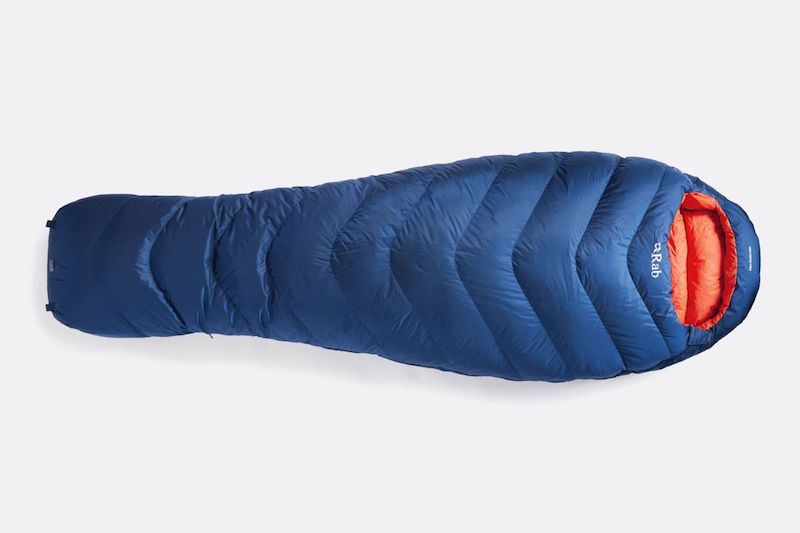
The Neutrino Pro 400 is hand-filled here in the UK (in Derbyshire) with top-quality 800 fill power ethically sourced European Goose Down that’s been given the Nikwax hydrophobic down treatment to give it improved performance in damp and wet conditions. This is contained in a series of trapezoid baffles throughout the bag that do a fantastic job of minimising cold spots and preventing migration.
The warmth of the bag is in-line with its -1C comfort rating, though I would have preferred more insulation around the foot box. In terms of fit, the Neutrino Pro 400 offer a large, unrestrictive fit, which I loved.
The outer of the bag is made from water-resistant Pertex Quantum Pro, providing tough-wearing performance at a low weight, and the included stuff-sack is waterproof, which is a great touch.
The two-way, anti-snag zip is backed by a substantial baffle, the large hood features an easy-to-use cinch cord, and hanging loops can be found at the bottom. There is a zipped pocket, though it’s pretty useless, being only big enough for an energy bar or two.
In a line: A roomy, comfortable and lightweight sleeping bag.
Weight: 8/10
Pack size: 8/10
Warmth: 7/10
Features: 9/10
Value: 8/10
Overall: 8/10
Haglofs L.I.M Down Sleeping Bag review
www.haglofs.com/gb/en | £350
When we think of Haglöfs we generally think of very good quality and innovative gear that always performs. For me, this has never been clearer than now, as I test the brand’s intriguing L.I.M Down sleeping bag.
The bag has been designed specifically with speed hikes and races in mind. As such, it is incredibly lightweight and packable. In fact, it’s the lightest (477g) and smallest (when packed) of any of the down sleeping bags on test.
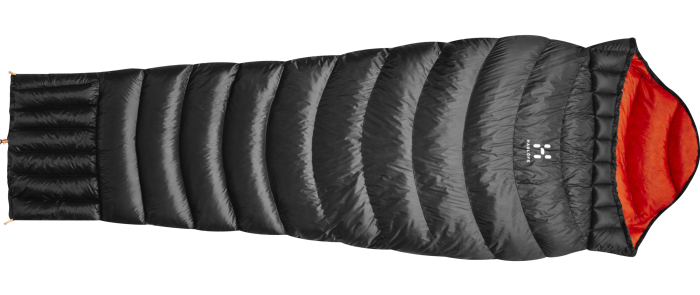
To achieve this light weight and small pack size, the brand has done away with both the zip and the bottom of the sleeping bag. Instead, there is a toggle at the bottom which cinches in and forms the bottom of the bag.
Surprisingly, the drawstring closure by the feet does a pretty good job at keeping the heat in, though we’re not convinced it’s as effective as a proper, insulated foot box.
The brand’s quest to go lightweight also means that there is little in the way of features. There is no neck baffle or interior pocket and the hood doesn’t shape to the head well, while the adjustment is very basic and straightforward. Despite this, the bag still manages to provide a lot of warmth, thanks to high quality 800 fill down insulation. With a lower comfort rating of 1C, there are warmer down sleeping bags on test.
With so many standard features, you may be questioning why this sleeping bag is one of the most expensive, but this will be down to the quality of materials used and, as we all know by now, lightweight gear usually entails a high price tag.
In a line: The Haglöfs L.I.M Down is an unbelievably lightweight and packable bag. This is one of the best down sleeping bags on the market for those on fast moving adventures.
Weight: 10/10
Pack size: 10/10
Warmth: 8/10
Features: 7/10
Value: 7/10
Overall: 8/10
Criterion Quantum 350 review
www.criterion-sleepingbags.co.uk | £345
Head to the Criterion website and you’d be forgiven for thinking that you’d loaded an archived web page from the early 2000s. It looks retro and, dare I say it, dated, but judge this brand’s kit by the design of its website at your peril.
Criterion has been in the sleeping bag game in one form or another for over 20 years, manufacturing top-quality down sleeping bags and clothing for use in extreme environments. In fact, the brand is keen to point out that the first ever winter ascent of Sisha Pangma in the Himalayas in 2005 featured Cumulus (the old brand name) sleeping bags at the 7,800m camp.
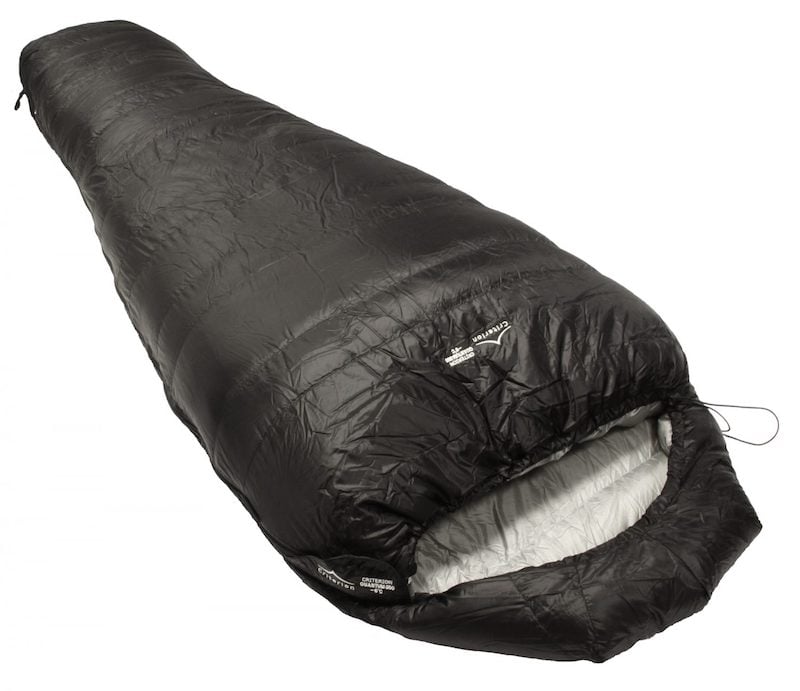
Safe to say, if you choose Criterion, you’ll be putting your faith in a company that’s done more than enough to earn it. The Criterion Quantum 350 which we tested in the Jan/Feb 2020 edition of Adventure Travel magazine is part of a wider range of three bags (the other two being the Quantum 200 and the warmer Quantum 450).
With a comfort rating of -6C, the Quantum 350 is a three-season bag. I must admit though, having used it in temperatures hovering just above freezing, the -6 comfort rating seems a bit of a stretch. Despite that, it weighs in at a very respectable 695g with a packsize just a little smaller than a football. Not bad at all.
The outer of the sleeping bag is made using Pertex Quantum, a lightweight shell fabric that’s constructed from fine yarns that trap air and help improve insulating efficiency. It’s supremely soft and has an excellent strength-to-weight ratio.
Inside, you’ll find 350g of 870 FP ethically sourced Polish goose down, which is contained by trapezoid baffles to help prevent cold spots. the full-length, two-way zip (which offers zip-together compatibility) is back for its length by a substantial baffle, ensuring no cold spots from there, and its anti-snag feature works very well.
Hanging loops on the foot box, en effective neck baffle, a small internal pocket, and an easy-to-use cinch cord around the hood round off the feature list of the Quantum 350.
If it’s a lightweight, packable down sleeping bag you’re after, there are worse things you can do that check out the Quantum 350.
In a line: Lightweight, exceptionally packable and very comfortable.
Weight: 9/10
Pack size: 9/10
Warmth: 7/10
Features: 7/10
Value: 9/10
Overall: 8/10
Mammut Sphere Down review
www.mammut.ch | £400
Founded in 1862, Mammut has a huge amount of history. The brand has long honed its ability to make kit that meets the needs of athletes and travellers. The Swiss brand’s entry into this test is the Sphere, a sleeping bag with a fill power of 800 and a lower comfort rating of -7C. The warmth is apparent minutes after you get in the bag and you would have no trouble keeping toasty on excursions in the UK.
The outer material is windproof and water repellent, which is great for those who enjoy wild camping without a tent. In terms of fit, you’ll find the bottom of the bag slightly slimmer than other down sleeping bags on test. Having said that, it’s not overly restrictive and it should help thermal efficiency. At 6ft 2in, the regular bag worked for me, but you may need the longer option if you’re any taller.
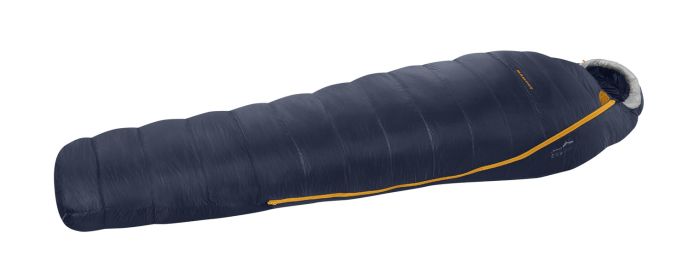
Despite Mammut saying the zip has been revised to reduce jamming, we actually found it to snag quite often. Ironically, it was actually catching on the anti-snag strip, so this wasn’t ideal.
We found the baffle running alongside the zip to be very effective and it always stayed in place. We were slightly disappointed that there was no proper neck baffle, with only a drawstring and some material in its place. Presumably, Mammut left it out in an effort to save weight and volume.
In truth, the quality of the down fill seems to make up for the extra warmth this would have provided. It’s also worth noting that the hood is well-designed and cinches in around the face in all the right places. The only irritating thing was that I did find the drawstring would occasionally flop onto my face.
In a line: It’s among the more expensive down sleeping bags, but the Mammut Sphere is a high-class performer.
Weight: 9/10
Pack size: 9/10
Warmth: 9/10
Features: 7/10
Value: 7/10
Overall: 8/10
This post was updated on 8/3/2021 to include the best down sleeping bags of 2021. To stay up to date with the latest gear news and reviews, or for inspiration for future adventures, check out the latest issue of Wired For Adventure magazine via our online shop.



